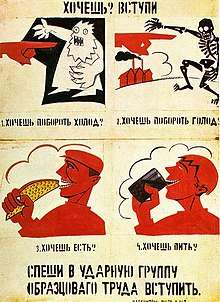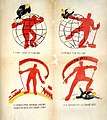ROSTA posters
ROSTA Posters (also known as ROSTA Windows, Russian: Окна РОСТА, ROSTA being an acronym for the Russian Telegraph Agency, the state news agency from 1918 to 1935) were a propagandistic medium of communication used in the Soviet Union to communicate important messages and instill specific beliefs and ideology within the minds of the masses.
Emergence
Style
Rosta posters were easily identifiable by their context and distinct style.
Agitprop
The basis for the content of ROSTA posters was political messages from the Soviet Union, sometimes referred to as agitprop. Agitprop is political propaganda, especially the communist propaganda used in Soviet Russia, that is spread to the general public through popular media such as literature, plays, pamphlets, films, and other art forms with an explicitly political message.
Examples
 Vladimir Mayakovsky, "Want it? Join"
Vladimir Mayakovsky, "Want it? Join" Vladimir Mayakovsky, "Poster #742"
Vladimir Mayakovsky, "Poster #742" Mayakovsky, "Мир стоит на вулкане"
Mayakovsky, "Мир стоит на вулкане"
References
- "Views and Re-Views: Soviet Political Posters and Cartoons | Artists: P-Z". library.brown.edu. Retrieved 2017-05-15.
- "Mikhail Mikhailovich Cheremnykh | The Art Institute of Chicago". www.artic.edu. Retrieved 2017-05-15.
- Lavin, Talia (2014-12-26). "35 Communist Propaganda Posters Illustrate The Art And Ideology Of Another Time". Huffington Post. Retrieved 2017-05-15.
- "agitprop | Soviet history". Encyclopedia Britannica. Retrieved 2017-05-15.
- Mayakovsky, Vladimir (2011-10-25). "Vladimir Mayakovsky". Vladimir Mayakovsky. Retrieved 2017-05-15.
- "Russian ROSTA posters | IISH". socialhistory.org. Retrieved 2017-05-15.
- "Mikhail Cheremnykh". TheFreeDictionary.com. Retrieved 2017-05-15.
- Ward, Alex (2008). Power to the People: Early Soviet Propaganda Posters in the Israel Museum, Jerusalem. London, UK, Ashgate, ISBN 0-85331-981-2